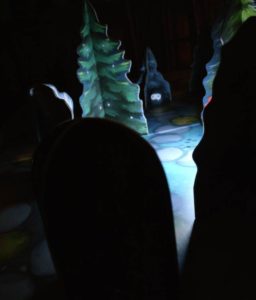Enter the Shadows
Looking for a completely new board game experience for the upcoming holidays? Check out Shadows in The Forest, by ThinkFun.
This review was originally published in the PlayInEducation newsletter.
Shadows in The Forest
Publisher: ThinkFun
Players: 2+ (best with at least 3)
Ages: 8 and Up
Genre: Light strategy

I see you!
Growing up in the country, night games of flashlight tag (or one of its endless variations) were the stuff of lazy summer nights. The kids would gather together after sunset, a game would be settled on, and we’d spend the next hour running around in the darkness, hiding in the shadows, and doing our best to jump scare each other.
If you aren’t familiar with these types of games, the idea is simple. One or more people hide in the darkness, while others try to spot them with flashlights. That description doesn’t do them justice. There’s an intense excitement to hiding in the shadows and dashing from hiding spot to hiding spot. I always found being the person more frightening, but just as much fun. Shadows in the Forest is the board game equivalent of those games. It’s exciting and fun and nerve-wracking all at once.
You play Shadows in the Forest in the dark. In fact, the darker the room, the better. One person plays the Seeker. The others play Shadowlings, cute little mask-wearing creatures that hide in the shadows.
If you’re the Seeker, you roll the glow-in-the-dark die, and then move your LED lantern around the board, looking for Shadowlings. If you spot one, you steal its mask. Get all the masks, and you win. After your turn ends, close your eyes. You have to keep them closed during the Shadowling’s turn. Actually, I’d recommend stuffing a pillow over your face just to be on the safe side.
The Shadowling players play all at once, moving more Shadowlings than there are players. You’ll have to work together, particularly if one of the Shadowlings loses a mask and you want to get it back. Be quiet, though. You don’t want the Seeker to hear you.
The board you’re playing on is a vision of a dark wilderness, with three-dimensional trees and rocks casting long confusing shadows. The Shadowlings themselves are pitch black, except for their reflective white masks.
Before I go into the educational benefits of the game, let me stress that this game is straight-out fun. The atmosphere, playing in the dark by the light of a little LED lantern, is phenomenal. The experience is even better. Playing as Shadowling means trying to whisper and point and second guess where the Seeker will go. Playing as the Seeker, you peer through the darkness and move your lantern, searching for patterns in the shadows and ways to isolate the Shadowlings.
Educational benefits
The first benefit that I’d like to point out is a weird one: cheating. This is a game that you can cheat at. The Shadowlings aren’t allowed to move through the light, but there’s no way for the Seeker (who has his eyes closed) to know if they do. As the Seeker, if you look down at the board from directly above, and let your eyes adjust to the light, you’ll probably be able to see the little dark globs of shadow that are the Shadowlings. Instead, you need to stay focused on the lantern.
Either method of cheating will destroy the game. You’ll lose all the suspense and fun, and it’ll be over.
Why is this an educational benefit? Because it’s so obvious. As long as you don’t cheat, this is one of the innovative and exciting games you’ll ever play.
When we played, the Seeker saw the problem immediately, and chose to keep his head low and close to the edge of the board. Other Seekers followed that pattern. We even had one moment where a player said “I can see that guy, but he’s not in the lantern light, so I’m not taking his mask.”
The Shadowlings on the other hand, had several moments where they accidentally moved into the light of the lantern, and called themselves on it.
That kind of good sportsmanship is tough to teach, but this game inspires it, and it does it without being preachy or condescending. It’s just fun.
There are other educational benefits. There’s strategy to being the Seeker, as you can position your lantern to close off sections of the board. There’s a huge cooperative play element, as Shadowlings work together to either hide and save each other.
Summing it all up
Shadows in the Forest is a lot of fun. The requirement of playing it in the dark pretty much eliminates it from classroom play, but if you’re a parent looking for a new experience to play with your kids, you need to give it a try. It’s easy to understand, fun to play, and a completely different experience from every other game night game. On top of all that, it helps reinforce a valuable lesson – that character and honesty are more important than winning.
Want to comment? Hit me up on Threads or Facebook!



